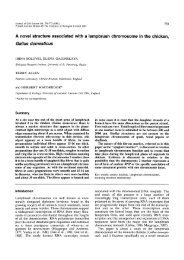European guidelines for youth AIDS peer education - University of ...
European guidelines for youth AIDS peer education - University of ...
European guidelines for youth AIDS peer education - University of ...
- No tags were found...
You also want an ePaper? Increase the reach of your titles
YUMPU automatically turns print PDFs into web optimized ePapers that Google loves.
Child-initiated,shared decisionswith adultsChild-initiatedand directedAdult-initiated,shared decisionswith childrenConsulted andin<strong>for</strong>medAssigned butin<strong>for</strong>medTokenismDecorationManipulationThe Ladder <strong>of</strong> ParticipationHart’s Ladder <strong>of</strong> Participation is frequently referred to in these<strong>guidelines</strong>. We have reproduced it here. Hart designed it as atypology to guide thinking about children’s participation.1 Manipulation. If young people have no understanding <strong>of</strong> theissues and hence do not understand their actions, then thisis manipulation.2 Decoration. This is described as one rung up from‘manipulation’ as the adults do not pretend that the cause isinspired by children. They simply use children to bolster theircause in an indirect way.3 Tokenism. Young people are given a voice, but in fact havelittle choice about the subject or the style <strong>of</strong> communicatingit, and little or no opportunity to <strong>for</strong>mulate their ownopinions. A good example is the token use <strong>of</strong> children onconference panels.4 Assigned but in<strong>for</strong>med. This rung <strong>of</strong> the ladder marks thestart <strong>of</strong> true participation.• The children understand the aims <strong>of</strong> the project;• They know who made the decisions concerning theirinvolvement and why;• They have a meaningful role;• They volunteer <strong>for</strong> this project after the project was madeclear to them.5 Consulted and in<strong>for</strong>med. The project is designed and run byadults, but young people understand the process and theiropinions are treated seriously.6 Adult-initiated, shared decisions. Though the projects areinitiated by adults, the decision-making is shared withyoung people.7 Child-initiated and directed. When the conditions aresupportive, even young children can work cooperatively inlarge groups.8 Child-initiated, shared decisions with adults. Projects likethese are all too rare. This is not due to the absence <strong>of</strong> adesire to be useful on the part <strong>of</strong> the teenagers. It is ratherthe absence <strong>of</strong> adults attuned to the particular interests <strong>of</strong>young people.(Source: Hart, R. 1992. Children’s participation: from tokenism to citizenship. Innocenti Essays. No. 4,UNICEF, New York, USA).Why <strong>AIDS</strong> <strong>peer</strong> <strong>education</strong>?Young people and adultsYoung people are equally or even more concerned about HIV than adults. In a 1995 survey conducted by the<strong>European</strong> Commission 5 based on 18,500 interviews in all EU member states, 80% <strong>of</strong> young people in the15–24 age group indicated they wanted more in<strong>for</strong>mation about HIV. Only 14% <strong>of</strong> young people believedthey would ‘never catch <strong>AIDS</strong>’, compared to 25% <strong>of</strong> adults. Young people were found to be better in<strong>for</strong>medthan adults about HIV transmission and protection.HIV and its spread is a collective concern involving everyone. Decision No. 747/96/EC by the <strong>European</strong>Parliament and Council rein<strong>for</strong>ces the point: ‘<strong>AIDS</strong> is a phenomenon that poses a dilemma not only <strong>for</strong> thoseparts <strong>of</strong> human relationships <strong>of</strong> most intimate concern to individuals, but also <strong>for</strong> modes <strong>of</strong> collective behaviour.’16 <strong>European</strong> <strong>guidelines</strong> <strong>for</strong> <strong>youth</strong> <strong>AIDS</strong> <strong>peer</strong> <strong>education</strong>
















